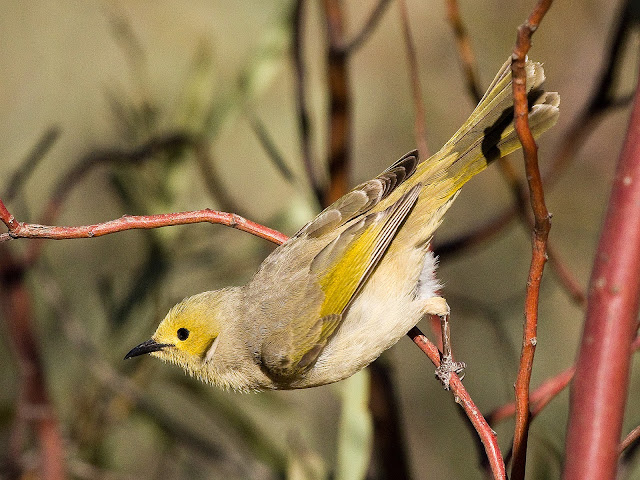We arrived in Alice early afternoon and made a visit to the Old Telegraph Station just outside the town. It shows the fascinating story of how the first telegraph line was established from Darwin down to Adelaide thus enabling direct communications to the southeast coast for the first time.
There were a good few Black and Whistling Kites around but none of the less common raptors. Plenty of birds but all ones I had seen before.
 |
| Black Kite |
 |
| Whistling Kite |
 |
| Crested Pigeon |
 |
| Galah |
The next morning we had a trip out into the Western McDonnell Ranges visiting Simpsons Gap and Standley Chasm. Fortunately a late start was scheduled, the only one on the trip, to allow a few brave souls to go ballooning over the desert. Myself, I was standing outside the Olive Pink Botanical Gardens at 0630 in the half light. Major problem, there was a high fence and a locked gate with a sign saying that the gardens did not open until 0800. I hadn't planned for this.
Fortunately one of the members of staff arrived at about 0700 and was happy to let me in early. A big relief, I was expecting to see the Western Bowerbird and this was one of my two main targets on the holiday. The other being the Cassowary which I was extremely unlikely to get to see.
 |
| Yellow-throated Miner |
 |
| Australian Ringneck - also called Port Lincoln Parrot |
 |
| White Plumed Honeyeater |
 |
| Grey-crowned Babbler |
 |
| Possible Little Crow |
I found the corvids very difficult to identify. Given the location this is likely to be a Little Crow or a Torresian Crow. In both species the eye is dark in the juvenile bird turning to white in an adult. I have probably seen both birds at some time on the tour but I am unable to call the difference.
 |
| Spinney-cheeked Honeyeater |
 |
| Wallaroo |
 |
| Grey Shrike-thrush |
 |
| Western Bowerbird |
Western Bowerbird. I knew this bird was there, I had researched it on the web from home and I even knew where to look for it in the Botanic Gardens. I can now say that I traveled to the other side of the world to twitch a bird. Fortunately I was the only one that did and I had it all to myself.
I had a quick look around to see if he had a bower but there were two birds present and I did not want to disturb them so backed off and left them to it.
 |
| Western Bowerbird |
 |
| Western Bowerbird |
 |
| Western Bowerbird |
 |
| Little Woodswallow |
We spent the next day travelling the 450 Kilometres from Alice to Yulara the town closest to Uluru (Ayers Rock).
 |
| Uluru (Picture by Sue) |
There was little change in the birds we saw but the background colour did change in keeping with the Red Centre.
 |
| Magpie Lark |
 |
| Another Grey Shrike Thrush |
 |
| Juvenile Pied Butcherbird |
Below the only snake that we came across during the trip. It's not a good shot and I did for an instant consider getting my gardening scissors out to tidy up the view. Then I remembered where I was. I think it's probably a Western Brown, very aggressive when threatened, very fast and highly venomous. The aboriginal name for it is Gwardar which translates to - go the long way around.
I usually stick to birds in these blogs and leave the touristy bits to others but I was saddened by Uluru. It has been a home for the Aboriginal people for a long time. Some would say 60,000 years. Two hundred years ago Europeans turned up and took ownership of the land. A concept that the Aboriginals did not understand.
I thought that the land around Uluru had been given back to the Anangu people but now I find that it has only been leased back to them without giving them control over access, tourism etc.
35 people have died climbing Uluru and many have had to be rescued. For safety reasons and because it has spiritual significance, the traditional owners of the site, the Anangu, have asked people not to climb the rock.
There are signs around the base of the rock......
......and what happens
"Either we can't spell or they can't read" says traditional owner Vince Forrester of the thousands of tourists that climb Uluru each year.
My views - I would love to climb the rock but this place deserves the same respect as any other religious site. Stop the climbing.
 |
| and more disrespect, this time from the Zebra finches |
Next stop The Top End via a flight to Alice and then another on to Darwin
Keep looking - four more blogs on Australia to follow

























Loving this set of accounts of your trip Martin. May wish to rethink the Singing Honeyeater here as a Yellow-throated Miner.
ReplyDeleteThanks Barry. I am not sure how I managed to make that mistake. I had it labelled up OK on the original shot. Pleased to get it corrected though. I like your very supportive way of saying - you got it wrong! Thanks also for the comment on the Itermediate Egret.
ReplyDelete